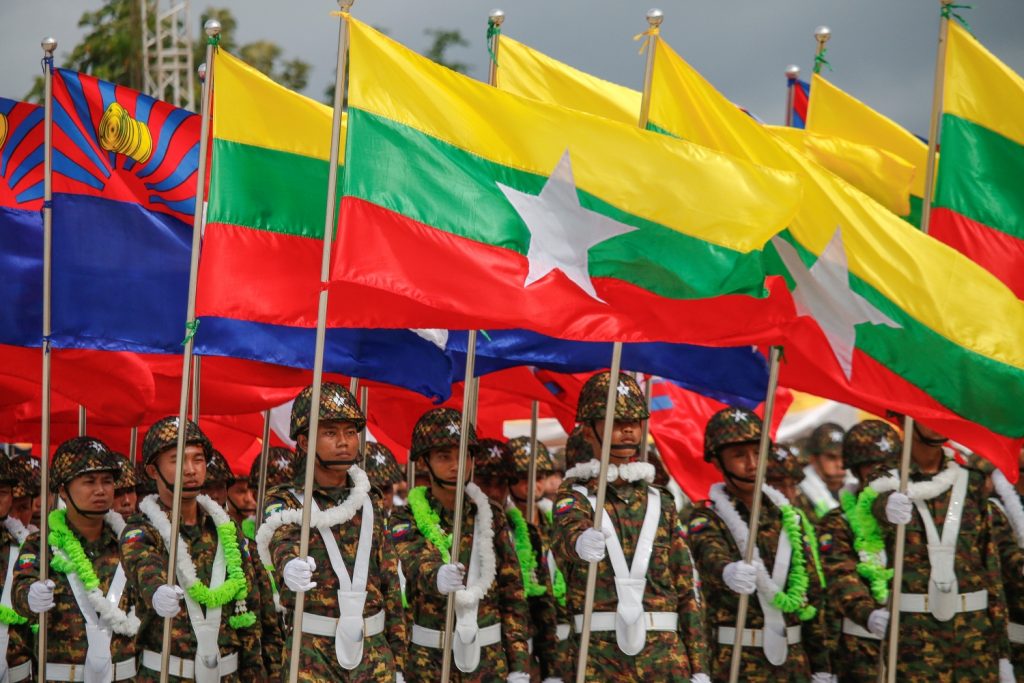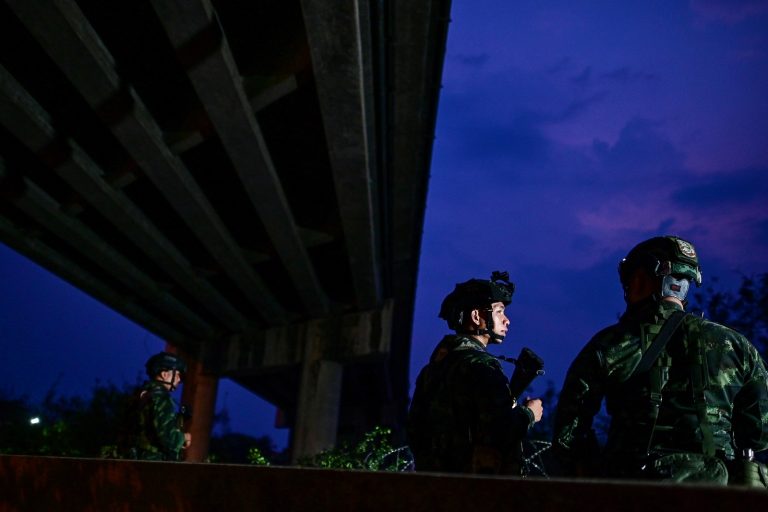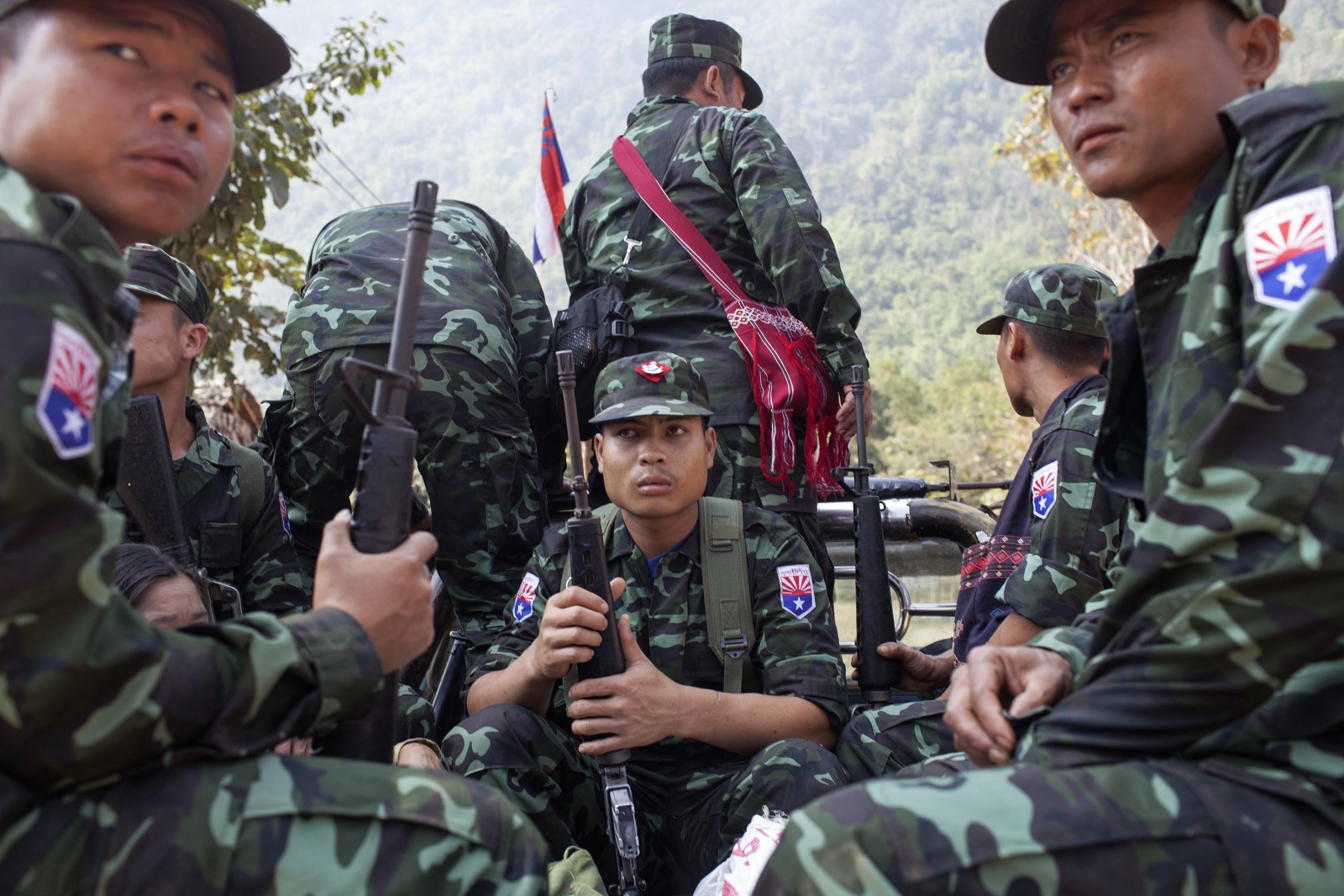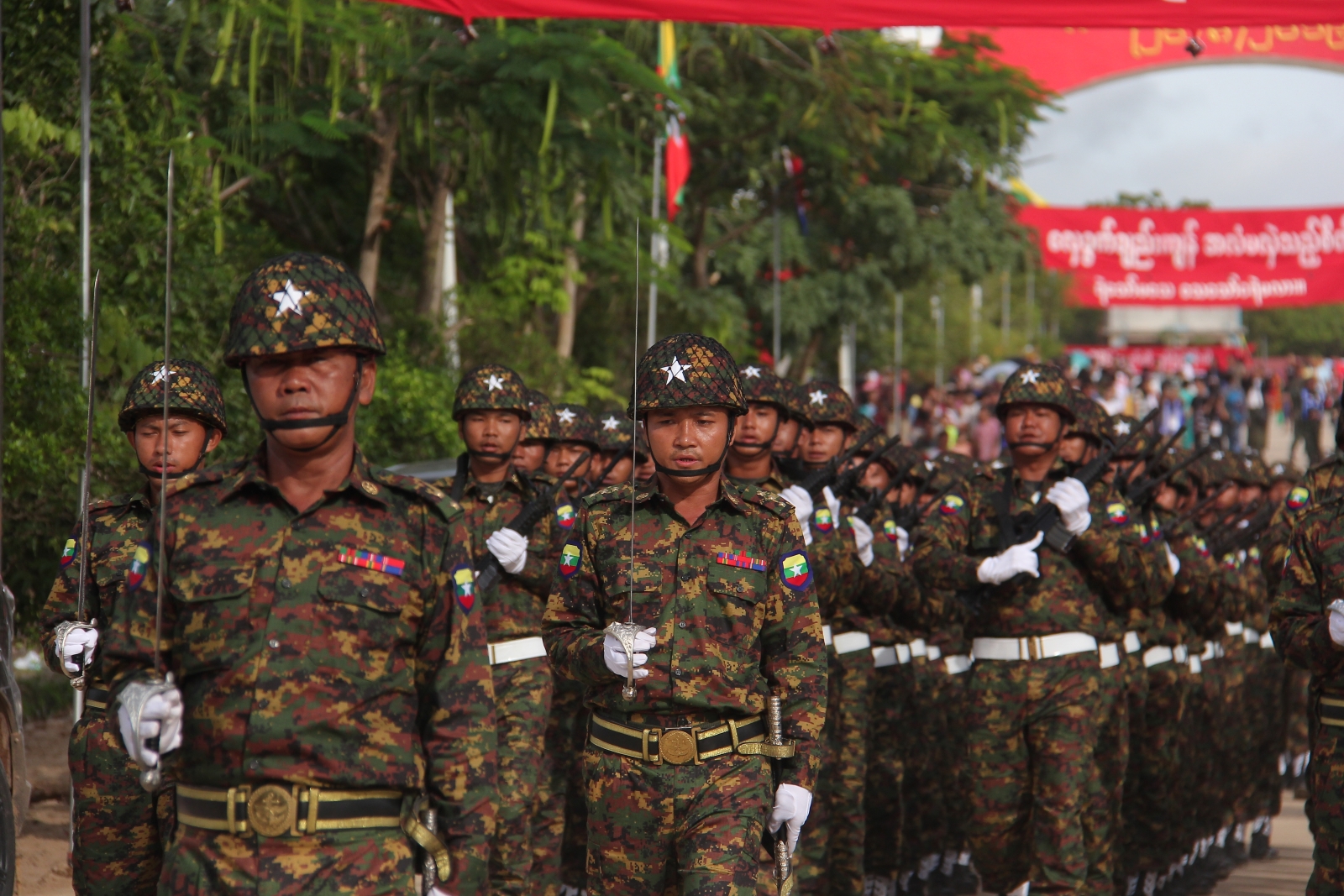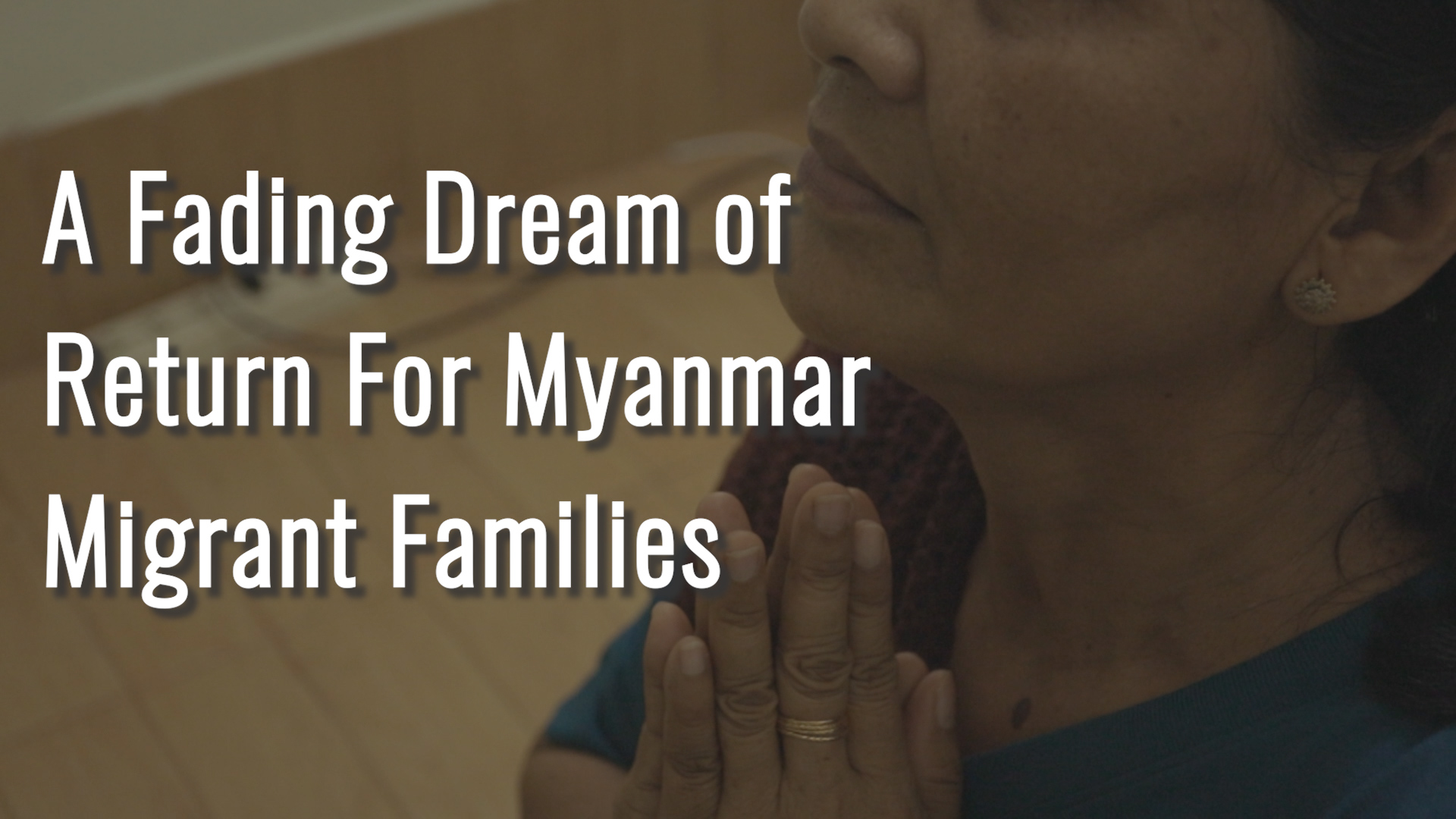The Border Guard Force’s support for the Tatmadaw in fighting the Karen National Union appears to have paid off, with the group getting the green light to resume its controversial businesses along the Thai border.
By FRONTIER
In the weeks leading up to the February 1 military coup, the Karen Border Guard Force was in crisis.
The National League for Democracy government was pursuing an investigation into the BGF’s Shwe Kokko project, which had allegedly become a hub for illegal online casinos. The Tatmadaw was pressuring the BGF, which is under its command, to give up its lucrative businesses. Three senior BGF officials, including the group’s nominal leader Colonel Saw Chit Thu, had submitted their resignations to the Tatmadaw, while rank and file members were threatening to quit en masse. The BGF was canvassing its options with other armed groups, and the prospect of renewed fighting hung over Kayin State.
Fast forward three months, and fighting has indeed engulfed the state – but not between the Tatmadaw and a renegade BGF. Rather, clashes between the Tatmadaw and the Karen National Liberation Army, the armed wing of the Karen National Union, have reached a level not seen in decades. The KNLA has retaken strategic outposts, including on the Thanlwin (Salween) River bordering Thailand, while the Tatmadaw has launched airstrikes that have forced tens of thousands of villagers to flee their homes.
The BGF has found itself providing valuable support to the Tatmadaw’s operations, and suddenly its problematic business dealings are no longer such a problem after all; its casinos and illegal trade gates on the Thai border have reopened, and a BGF member told Frontier there was even talk of the Shwe Kokko project being resumed as a joint venture with the Tatmadaw. But facing off against fellow Karen soldiers has created new tensions that the KNU is increasingly seeking to take advantage of, in order to realise a long-held policy of reuniting the various Karen armed groups.

Waging the Tatmadaw’s war
When mass anti-protests erupted across the country in early February, thousands of demonstrators took to the streets in Kayin. In the town of Myawaddy on the Thai border, BGF forces supported Tatmadaw crackdowns on demonstrators, while in other areas the KNLA escorted protesters to ensure their safety.
From the start the KNU issued strong statements against the coup, and began engaging the Committee Representing the Pyidaungsu Hluttaw and, later, the National Unity Government, which was formed by elected MPs and ethnic leaders in mid-April as an underground administration. It also accepted fleeing activists and workers who had joined the Civil Disobedience Movement, and later protesters began to arrive in its territory seeking training to take the fight to Tatmadaw.
Against this backdrop, clashes between the Tatmadaw and KNLA, which had mostly been limited to areas of Hpapun Township in northern Kayin and Kyaukkyi Township in eastern Bago Region prior to the coup, soon began to escalate and spread.
On March 27, the KNLA seized the Thee Mu Hta military base in Hpapun, leaving several Tatmadaw soldiers dead. The military responded almost immediately with airstrikes – the first such attacks in Kayin for decades.
In the days afterwards, the BGF began dispatching groups of 50 to 200 soldiers to support the Tatmadaw in conflict zones around Kayin and beyond, members of the group told Frontier. BGF forces were also brought in to increase security in towns around the state, they said.
In one case, a BGF battalion commander, Major Mann Win Yone, led a force of around 100 soldiers to Kayin’s Kyainseikgyi Township to spearhead fighting against the KNLA.
BGF forces have also been sent to Kayin’s Hpapun and Kawkareik townships, Thaton Township in Mon State, and even to parts of Tanintharyi Region, according to a BGF soldier who was sent to Kyainseikgyi on April 10 in a deployment of 50 soldiers. It’s unclear how many have been sent in total, but sources suggest it could be between 500 and 1,000 men. The BGF has an official fighting force of 3,000, although claims to have another 5,000 in reserve forces.
“It’s not like we sent 400 or 500 soldiers to help the military in one location,” the BGF soldier said. “They selected people based on where they’re from, and sent them to those areas so they can provide local knowledge.”
But the deployments didn’t go entirely to plan, said a high-ranking BGF member, who also spoke on condition of anonymity.
“Some BGF soldiers complained to their officers that they didn’t want to fight against their own ethnic people, even if they are from opposing armed groups,” he said. “During some clashes, the KNU soldiers shouted in Karen language that they don’t want to shoot Karen soldiers, and that we should get the Bamar soldiers to advance rather than BGF members.”
The member said Major Nai Maung Zaw, the BGF’s information officer, had later been sent to the front in Kyainseikgyi in order to better supervise BGF forces. In addition to his job as spokesperson for the BGF, Nai Maung Zaw plays an important role in ensuring troop discipline, the official said, and BGF soldiers were intimidated by his presence on the front lines.
“We’re not comfortable fighting against fellow Karen,” he said. “That’s why the headquarters sent more disciplined officers to manage and motivate us.”
Nai Maung Zaw could not be reached for comment. Photos and posts on his Facebook account indicate that he has recently been at the front line overseeing BGF soldiers.
On May 7, he posted that he was in Noetday village in the Manerplaw area to attend a Karen literature event and donate rice and other food to residents. “This food from the BGF has been donated to the villagers under the direction of Colonel Saw Chit Thu,” he wrote.

Fighting erupts
Initially, the deployments resulted in few clashes. The KNU’s foreign affairs chief, Padoh Saw Taw Nee, confirmed to Frontier that there had been fighting between KNLA soldiers and BGF members serving alongside the Tatmadaw, but the number of clashes was not high.
“Sometimes there are situations where Karen people are fighting against each other because the Tatmadaw uses the BGF on the front lines,” he said in an interview on April 25.
More recently, though, officials from the KNLA’s 5th Brigade have suggested the number of BGF forces on the front lines is increasing.
Based in Hpapun, or what the KNU calls Mutraw District, the 5th Brigade has accounted for a large proportion of the clashes with the Tatmadaw, and has managed to seize several strategic outposts. It has also cut off Tatmadaw resupply routes, leaving some military posts in Hpapun short of supplies.
Spokesman Colonel Saw Klerdoh said that about 200 Tatmadaw soldiers had been killed and more than 200 seriously injured in fighting with the 5th Brigade since the third week of March. “If fighting with all [KNLA] brigades was counted, I think the casualties on the Tatmadaw side would be double,” he said.
As casualties mount, BGF soldiers are being sent to replace Tatmadaw soldiers, Saw Klerdoh said. A small number were sent to Hpapun in early April, he added, but most have arrived since late April.
“We think that an extra 500 BGF soldiers were sent here recently,” he said. “But we’re obviously not able to go and do an exact count. Certainly, we’ve seen that BGF soldiers are present.”
The BGF member confirmed to Frontier on May 6 that two groups of BGF soldiers were sent to Hpapun in recent weeks.
“The first group was sent in the last week of April and the second group on May 2,” he said. “There were about 150 to 200 people in each group, so there might be around 400 BGF soldiers there in total.”
Saw Chit Thu confirmed in an interview on May 6 that the BGF sent around 200 troops to Hpapun, but claimed they were only there to provide “security” after two of its battalions there had become trapped and requested help. He insisted BGF troops had been ordered not to shoot at the KNLA, and said he would “take responsibility” if fighting broke out.
Just three days later, videos on social media showed another 100 BGF soldiers heading to Hpapun from the Myaing Gyi Ngu area, and that same day clashes were reported, with several BGF soldiers apparently killed. Salween Press reported on May 10 that there were now about 600 BGF soldiers fighting alongside the Tatmadaw.
Mr Kim Jolliffe, an independent researcher who has studied Karen armed groups for more than a decade, said the appearance of BGF forces on the front lines was unsurprising, as its battalions take their orders from the Tatmadaw. Each battalion officially has 32 Tatmadaw officers and support staff alongside the Karen fighters.
“It’s not so much ‘fighting between the BGF and KNLA’ as ‘Tatmadaw using BGF forces’ or ‘BGF supporting Tatmadaw operations’,” he said.
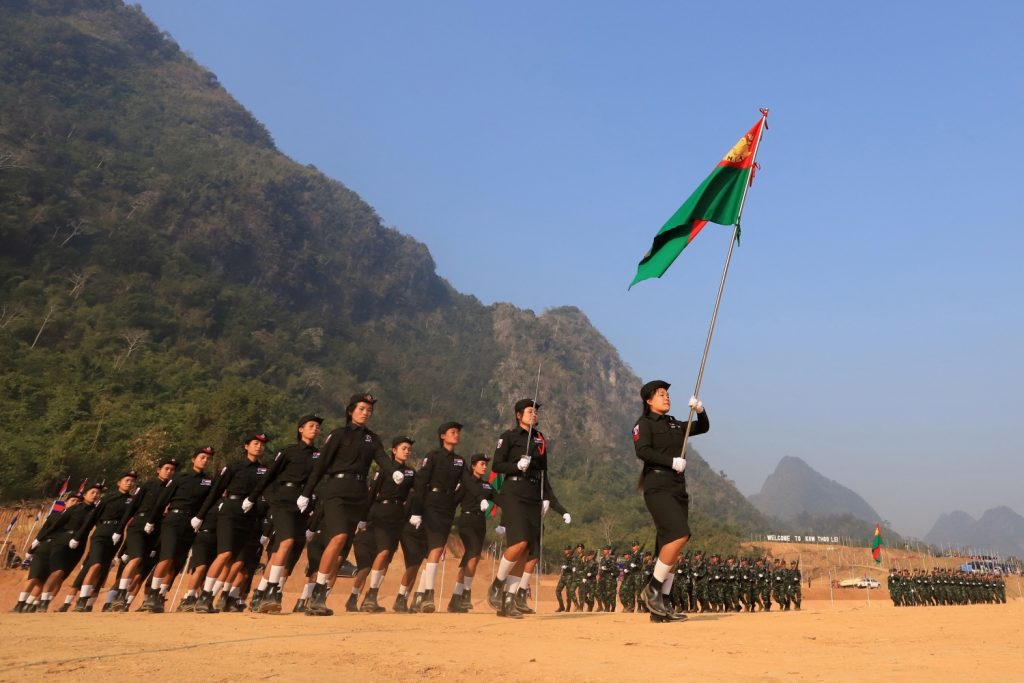
A plea for unity
But there is undoubtedly a history of bad blood between the KNU and BGF, who have been on opposite sides of the conflict in southeastern Myanmar since the mid-1990s.
Although the BGF was established shortly before the 2010 election, when the Tatmadaw pressured members of the Democratic Karen Buddhist Army to sign up for the Border Guard Force plan, its roots trace back to 1994.
That year, Buddhist KNLA soldiers broke away from the largely Christian-led KNU due to perceived religious discrimination and formed the DKBA. They aligned themselves with the Tatmadaw and played a crucial role in seizing the KNU headquarters at Manerplaw in January 1995, and were later rewarded with lucrative business concessions and large land holdings. Many KNU members and supporters regard them as traitors to the cause of Karen self-determination.
Today the BGF comprises 13 battalions, which are nominally overseen by Saw Chit Thu from his headquarters at Shwe Kokko, about 20 kilometres north of the border town of Myawaddy.
However, Jolliffe cautioned that the BGF should not be seen as monolithic. Chit Thu exerts more control over battalions in central areas than those around Hpapun in the north or Three Pagodas Pass in the south. “It’s not unusual for the BGF and KNLA to fight each other in the 5th Brigade area,” he said. “They are in fierce competition and have very low trust around there.”
Since BGF soldiers began arriving in Hpapun in larger numbers, the KNLA leadership has issued a call for unity with the BGF, as well as two other Karen armed groups that recently met the Tatmadaw’s peace team – the Democratic Karen Benevolent Army (not to be confused with the similarly named BGF-precursor group) and KNU/KNLA Peace Council.
In a letter to the groups on May 2, KNLA vice chief of staff Lieutenant-General Baw Kyaw Heh said the current political crisis represented the best opportunity in seven decades to achieve self-determination for the Karen people. “Take advantage of this and fight against the Bamar military dictatorship,” he wrote, before specifically addressing the BGF. “So BGF, as you are Karen, you need to think carefully about it and make the right decision … Karen people should not be killing each other.”
Jolliffe said uniting the various Karen armed groups was a longstanding policy for the KNU, and it had seen some success. It was partly because of the KNU’s influence that, in 2010, a faction of Democratic Karen BuddhistArmy soldiers refused to join the Tatmadaw’s Border Guard Force programme with most of their colleagues and broke away to form the Democratic Karen Benevolent Army. Both it and the KNU/KNLA Peace Council have largely followed the KNU’s political lead since then, he said, but the KNU has not succeeded in getting the BGF battalions on board.
He said recent political upheaval – including the coup, the rising conflict in Kayin and the Tatmadaw’s stand-off with the BGF in January – could change the equation, though.
“The gravity of the situation and the opportunity to force the Tatmadaw back probably gives the whole idea of uniting Karen armed groups a lot more impetus,” Jolliffe said. “In the past, the differences between the BGF and KNLA were too deep. But if the State Administration Council continues to weaken, the KNU could become a more viable patron once again and a new alliance could be formed.”

Back in business
The Tatmadaw seems to be making efforts to shore up BGF support, however. At the same time as Karen BGF forces were being dispatched around Kayin and beyond to respond to the KNLA threat, some of the group’s businesses enjoyed a sudden improvement in fortunes.
The BGF member said the group’s casinos and border trade gates along the Thaung Yin (Moei) River, which marks the international border between Myawaddy and the Thai town of Mae Sot, had all reopened since early April after a year’s closure due to the COVID-19 pandemic.
“Basically, things have gone back to normal since the coup. The casinos have been open since early April and during Thingyan they remained open for some VIPs,” he said. “There have also been talks for some new joint ventures with the Tatmadaw … we might have to split the profits in half.”
Meanwhile, he said the BGF is still negotiating with the military to resume work on the Yatai New City, a purported $15 billion property development at the BGF headquarters of Shwe Kokko. The project is a joint venture between a BGF company and Yatai International, a Hong Kong-registered company set up by a shadowy ethnic Chinese businessman who is reportedly wanted in China on gambling charges, and has been described as a front for online gambling operations targeting Chinese nationals. Work on Yatai New City halted last year after the NLD government launched an investigation into the project.
“Before the coup, the military didn’t allow us to continue the Shwe Kokko project, but now we’ve heard that they will allow us to resume it as a joint venture with the Tatmadaw. They will also stop the investigation launched by the NLD government,” the BGF member said.
“We’re not privy to discussions about profit sharing and what agreement the BGF has made with the military exactly, but I know for a fact that most businesses resumed in April because I was on security at some of the sites.”
On social media BGF members have speculated that its leaders have cut a deal with the Tatmadaw to resume their business activities in exchange for fighting against the KNU.
In a private group for BGF supporters, one account approvingly described it as a “give and take” arrangement, under which the BGF had to send its troops to support the Tatmadaw against the KNU.
“Our leaders won’t consider anything other than what’s best for the development of our people and our region. KNU supporters will call them traitors, but they won’t care. He [Chit Thu] will do anything for the benefit of the people in his area. He will do it for us,” the user said.
Writing under a fake name, another BGF member said, “We will resume businesses in our Shwe Kokko area. Once construction is complete, the business will start and our area will develop. At a time when Burma is poor, our leader is beginning to make opportunities for us.”

Border trade booms again
One of the BGF’s most lucrative businesses is a series of 27 illegal crossings along the Thaung Yin River in Myawaddy. Traders use them to skirt restrictions and taxes on particular products, usually imports from Thailand, and to send workers to Thailand.
Goods pass through Customs checkpoints on the Thai side and are then loaded onto small boats that ferry them across the narrow waterway to the Myanmar side, where they are temporarily stored in warehouses run by the BGF. Distributors then collect the goods and send them out across the country. These “boat gates” have been operating for decades and typically handle around 60 percent of all trade through Myawaddy – up to US$1.5 billion in goods a year.
But as COVID-19 spread across the region in March last year, the BGF was forced to suddenly close the gates, shutting off access to a range of products and depriving it of informal income. The KNU and Democratic Karen Benevolent Army also closed seven gates that they had been operating.
Traders and BGF sources told Frontier that the gates reopened in early April this year and were already busy with shipments from Thailand of beer, energy drinks, coffeemix, teamix and dairy products, though still not as busy as pre-COVID times.
U Maung Nyunt runs a boat at one of the BGF gates, where each day he ferries up to 30 boatloads of goods from Thailand to the Myanmar side of the river. Each time he crosses the Thaung Yin, Maung Nyunt pays a K5,000 fee to the BGF. But the force also levies a range of other fees on importers, based on the volume and value of what they’re importing.
“Those who [import] things like beer and energy drinks rent space in warehouses at the BGF gate and then later take the goods out for distribution,” he said.
Maung Nyunt said that while he’s pleased to get his old job back, he’s making less money than before and fearful for his safety.
“Generally, I’m upset about the coup – I voted for the NLD in the November election,” he said. “When I return home after work, I feel unsafe. I want to live in peace and just have a regular income like before. Now I have a job, but I’m afraid of everything.”
Maung Nyunt may soon find himself busier, however, thanks to a ban on the import of five products from Thailand through formal trade that came into effect on May 1. Imports to Myanmar of the products – soft drinks, fruit juices, instant coffee, condensed sweetened milk and fresh milk– usually total around 10 billion baht ($320 million) a year, most of which goes through Myawaddy.
It’s not entirely clear why Myanmar’s Customs Department introduced the ban, with Thai media speculating it could be related to calls for a public boycott of products linked to the military. Since seizing power, the military regime has also regularly discussed the need to replace imports with domestically produced goods to reduce the trade deficit. The department’s April 22 statement said the ban was due to “preparation of food safety inspection infrastructure in border areas”.
Imports of the products are still permitted through sea-bound trade, but Thai traders have complained this is slower and more expensive.
Sources in Myawaddy, including Customs officials, said it was inevitable that traders would instead just send the banned products through the BGF boat gates to get around the restrictions.
“These are among the most popular products that come over the bridges through formal trade,” said one Customs official. “They’ll just send them on the boats instead.”
Myawaddy-based trader U Aung Soe said this meant there were unlikely to be any shortages of the banned products.
“When the government temporarily blocks the import of some products, they just go to the boat gate,” he said. “This always happens – the bans are never very effective.”


